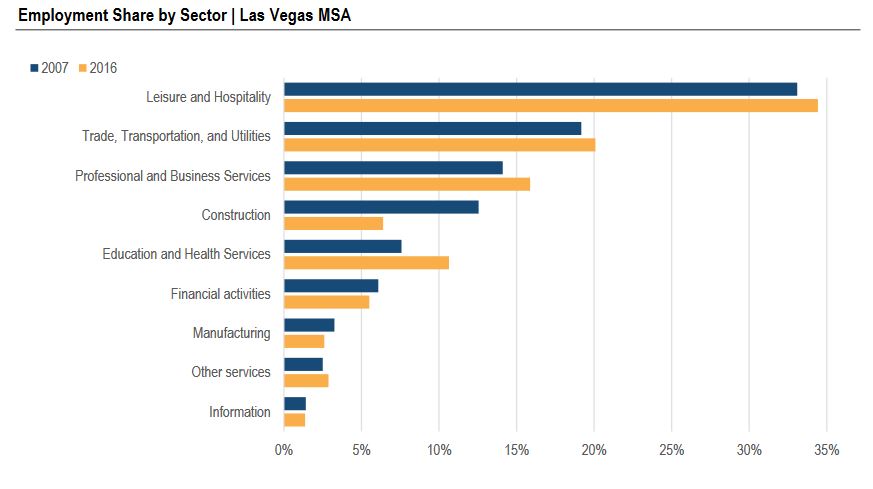Below is a chart, recently published by the Las Vegas Global Economic Alliance and based on Bureau of Labor Statistics data, and I have a question: Does this look like economic diversification to you?

Because it doesn’t to me. “Leisure and hospitality,” our Ur industry from time immemorial, accounted for a larger percentage of the workforce in 2016 than it did a decade ago. The same goes for “trade, transportation and utilities,” which includes a lot of retail workers, and “professional and business services,” which includes a lot of janitors, landscapers and security guards.
There’s an argument to be made that the economy has diversified within leisure and hospitality – not just because non-gambling revenue continues to grow relative to gambling revenue, but also because of the changing nature of the jobs within that industry — more people do their jobs with techy-techy of some sort due to many casinos now operating online like these you can find over at https://www.paybyphonebillcasino.uk/casinos-not-on-gamstop/ and similar sources, for instance. So there’s that.
There’s also this: Manufacturing, often touted as one of the savior sectors of tomorrow’s diversified economy, accounted for a smaller percentage of the area workforce in 2016 than it did in 2007.
The decline of construction’s share of employment, coupled with the expansion of “education and health services,” is the single biggest “diversification” play, if you want to think of it like that.
And LVGEA, in it’s “Workforce Report Card,” does seem to want think of it like that: “That shift of jobs between two large employment sectors demonstrates the evolutionary nature of the Southern Nevada workforce and its ability to expand and contract within industries to meet the ever-changing needs of the economy as a whole.”
The LVGEA is an economic development agency, and economic development professionals take a back seat to no one, not even their closely related kin in public relations, when it comes to relentless optimism. So from LVGEA’s point of view, the fact that there are fewer construction jobs but more education and health services jobs just goes to show that Southern Nevada has a nimble workforce poised to meet the jobs of tomorrow. And that would be encouraging — if so many education and health services jobs weren’t filled by home health aides making $10 an hour.
To its credit, LVGEA’s “Workforce Report Card” mostly refrains from the trendy “skills gap” narrative that characterizes so much “workforce development” chatter lately.
For my part, I refrained from reading the report’s entire 68 pages. I did however do the “control f” thing on my keyboard and found one (1) very brief discussion of wages paid to Southern Nevada’s workforce. At $11.83 an hour, the median wage for Southern Nevada’s largest occupational group (you guessed it – food prep & serving) is higher than the national average. Alas, the LVGEA report left out a couple key points so allow me to expand on that good news: A) that’s thanks mostly to the Culinary, and b) it’s still too damned low. Maybe the governor can get somebody to do a 68-page report on that.
Meantime, as for economic diversification creating all those high-paying jobs in exciting new sectors so we won’t have to worry about low-paying jobs anyway because there will be so many high-paying jobs so yippee etc. … well, that chart not only suggests we’re a hell of a long way from that, but also that our progress is a lot slower than one of the governor’s press releases would have you believe.